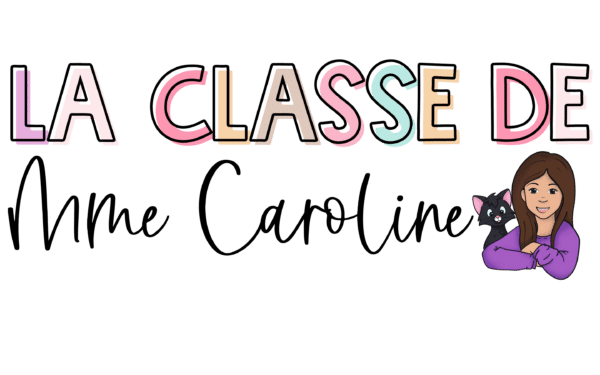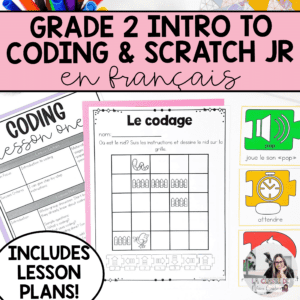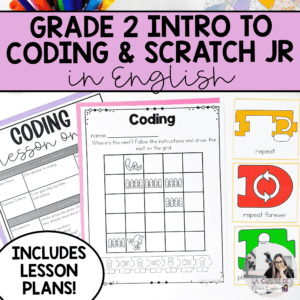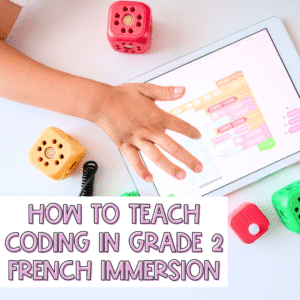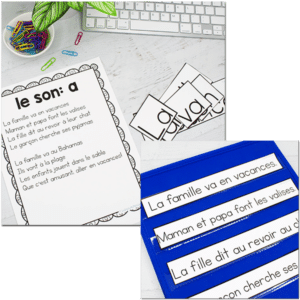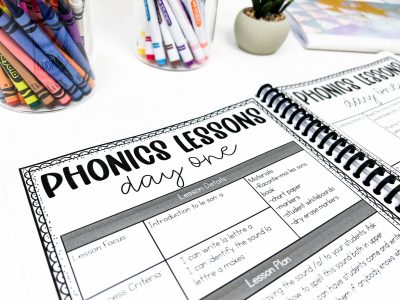If you’re like me, you probably felt a wave of anxiety when you realized coding was being added to the curriculum. I had no idea how I was going to teach it! The idea of teaching coding in Grade 2 seemed so complex.
But we can do hard things! I asked around and did a bunch of research and found some great ways to introduce coding in Grade 2 that helped them learn it effortlessly. Now, coding is one of my students’ favourite subjects! They get so excited when it’s time to take out the iPads.
In this guide, I want to share what has worked to make coding fun and simple to teach. I’ll walk through how we start with offline activities, move to hands-on coding robots, and then finally dig into Scratch Jr. on the iPads.
My hope is that these ideas help you feel excitement rather than anxiety when it comes to coding! Our students are ready for this – we just have to guide their learning with engaging activities that set them up for success.
Let’s get into this. Oh, and if you’re looking to teach coding in Grade 1, you can find my guide here.
This post may contain affiliate links. Read my disclosure policy.
How to Introduce Coding in Grade 2
When it comes to teaching coding to second graders, it can seem intimidating to dive right into screen-based apps. That’s why I recommend starting offline, moving to hands-on robotics, and then finally bringing in the iPad. My 3-step approach looks like this:
Step 1: Start with Paper-based Activities
Paper-based activities are a perfect way to introduce coding in Grade 2 by teaching them critical thinking skills without overwhelming them. The hands-on nature keeps students engaged as they map out step-by-step paths just like a computer program. Here’s how it works:
- Use grid paper – Hand out grid paper and have students plot a course from Point A (start) to Point B (end). This translates coding logic into simple navigation.
- Make it relatable – I like to use a bird and nest theme. Students map the path for a bird to take from its start location to get back to its nest. This gives the activity a concrete framework kids can grasp.
- Write precise sequences – Students write coded sequences like “Move forward 4 squares, turn right, move forward 3 squares.” Peer-checking each other’s instructions reinforces attention to detail.
- Add obstacles – Once they have the hang of basic sequences, I toss in obstacles – fences to navigate around or worms to munch for energy before continuing. This mimics real coding challenges in a simple way.
- Solidify learning – Creating obstacles provides great problem-solving tasks. Students learn how tweaking a sequence can drastically change outcomes as they guide their bird home.
- Need a free activity, complete with a lesson plan? – Grab this free Grade 2 coding lesson plan and activity to help you introduce the topic to your class.
While basic on the surface, these paper coding challenges teach the foundations of sequences, repeat loops, and debugging – core coding concepts! Kids have a blast while sharpening their logical thinking abilities. And the best part? No screens required! You’d be surprised how sophisticated their coding can get, even with just paper and pencil.

Step 2: Use a Coding Robot
If your students enjoyed plotting routes on paper, just wait until you introduce a programmable robot! Tactile bots like BeeBots, Botleys and MouseBots bring coding to life for young learners. I’d highly recommend adding one to your toolkit.
- Engaging for all learners – Coding robots appeal visually and hands-on to engage diverse students. Struggling learners often shine, getting the bot to move.
- Build computational thinking – Physically seeing their code control the bot builds connection between commands and consequences. Students debug naturally.
- Flexible activities – Our MouseBot came with building grids, direction cards, tasks and more. I also love creating my own increasingly tricky courses to challenge their code.
- Immediate feedback – Does their code work? Kids see instantly if their bot reaches the cheese or gets stuck at a dead end. They also see right away if they need to add more steps. This interactivity reinforces learning.
- Group collaboration – Students can work together to create courses or relay code instructions verbally to maneuver the bot. Develops communication and teamwork.
- Light bulb moments – I live for those reactions when their bot executes a tough sequence correctly, and they jump up shouting with hands in the air! Coding confidence ignites.
Moving from paper plotting to guiding roving robots keeps the momentum going. My students progressed so quickly, having the hands-on, dynamic bot as their outlet for coding creations. I know yours will, too!

Step 3: Introduce Coding with Scratch Jr
By now, your second graders are primed to take their coding skills digital with ScratchJr – the kid-friendly app from MIT. With ScratchJr, students can create interactive stories, animations, games and more using simple block coding that snaps together like puzzles.
The visual programming makes core concepts like sequences intuitive.
- Explore first – Let kids openly click, snap blocks together and test possibilities without structure at first. This playground time builds comfort with drag-and-drop building.
Introduce block types – Once they’ve explored, teach what each block category does – events, controls, looks, sound, etc. Have them make projects focused on specific blocks like animation.
| Yellow | Triggering Blocks (trigger the start of the animation) |
| Blue | Motion Blocks (movement) |
| Purple | Looks Blocks (changes the way the sprites look) |
| Green | Sound Blocks (choose from sounds provided or record your own) |
| Orange | Control Blocks (wait, repeat, stop, etc.) |
| Red | End Blocks (finish the animation) |
- Set creative challenges – Pose story prompts, anchor the projects around classroom topics, encourage them to use point tallying – structured tasks grow skills.
- Share out – Have students demonstrate their interactive stories to peers. Teach them to explain their sequence and code – builds presentation confidence!
- Collaborate – Pair up students to work cooperatively on one iPad combining visions. They’ll learn from each other while sharing the coding fun.
- Assess learning – Use their ScratchJr creations to assess comprehension of concepts you’ve covered – they love showing their learning through coding!
Before you know it, you’ll have Grade 2 coding experts constructing impressive interactive tales complete with dialogue, full sound effects and sprite animation that would wow even confident adult coders! Enjoy watching them build creativity.

Conclusion
Whew, we just covered a ton of ground on how to introduce coding to second graders! I don’t know about you, but I’m feeling pumped and excited to help our students dive into this crucial skill.
We broke the coding process down into three fun, hands-on steps:
- Start with grids – Plot routes, add twists!
- Move with bots – Code movement!
- Imagine with ScratchJr – Create adventures!
Ultimately, coding is essential for kiddos to grasp as our world uses technology more each day. But it absolutely can feel understandable and engaging at this age when we build up the foundation properly!
I’m here to help – download my Grade 2 coding mini unit, and let’s do this together! You’ll get printables for paper challenges, lesson plans, assessment rubrics, scratch project ideas, posters, and more.

